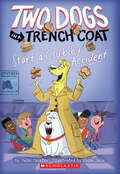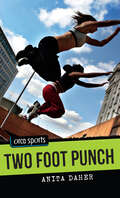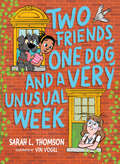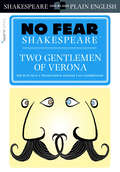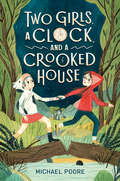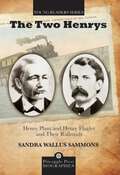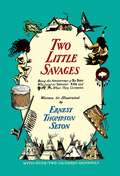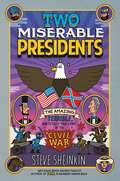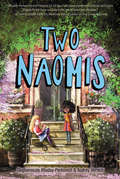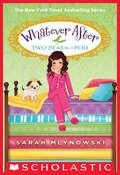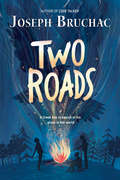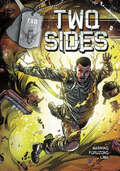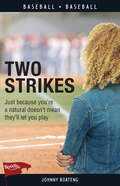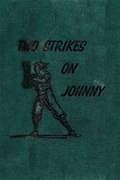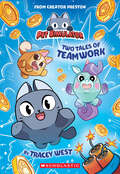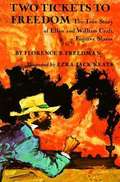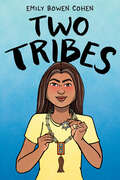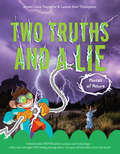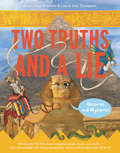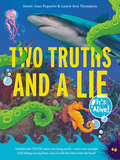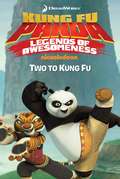- Table View
- List View
Two Dogs in a Trench Coat Start a Club by Accident (Two Dogs in a Trench Coat #2)
by Julie FalatkoGood dogs Sassy and Waldo start their own after school club and they don't even realize it!Sassy and Waldo love school!They get to wear a trench coat and everyone thinks they're a new student named Salty.Except Stewart. He knows the truth.But then Stewart has to stay after school for a club.Sassy and Waldo know that a club is a sandwich. But it's not that kind of club.Sassy and Waldo go to the best place to wait for Stewart in the empty school: the cafeteria! Snacks! Running! Places to nap!Their classmates find out what Salty is doing there and they want in on the club.Only it's not the sandwich kind.
Two Foot Punch (Orca Sports)
by Anita DaherNikki blames her brother, Derek, for their parents' death in a house fire, but when Derek gets involved with a gang, Nikki knows she is the only one who can save him. Enlisting the help of a girl named Rain, who uses her athletic abilities to carry out acts of petty thievery, Nikki uses all her gymnastic and free-running skills to stay ahead of the gang and keep her brother from being killed.
Two Friends, One Dog, and a Very Unusual Week
by Sarah L. ThomsonTake Pippi Longstocking&’s joie de vivre, blend it with a 21st century urban setting, toss in a dog named Otto for good measure and what do you get? This joyfully carefree story about two unlikely friends.It&’s a pair of silver sequined sneakers that unexpectedly flips Emily&’s comfortable, predictable world upside down. Or, more precisely, it&’s the girl wearing them.The shoes belong to Rani, who moves into Emily&’s apartment building—and her life—with absolutely no one but her dog Otto. (Her research scientist mother is away in Patagonia.) And that&’s only the first rule that Emily watches Rani break without hesitation.But it&’s not just that Rani breaks rules. Most of the time, she doesn&’t seem to know the rules exist. Why can&’t she bungee jump off their building? Or bring an ice cream truck to school?For steady and orderly Emily, Rani&’s approach to life feels impossible . . . and more than a little irresistible. But is there a place for her in Rani&’s world? And should she find a way to make space for Rani in her own?A Junior Library Guild Gold Standard Selection
Two Fur One (Home for Meow)
by Reese EschmannAll the "awwws" of animal adoption stories are combined with sugary sweetness in this new, fun-filled chapter book series about a cat café!Every home needs a cat!Kira Parker lives above The Purrfect Cup, the cat café that her family owns and runs. When her parents decide they want to renovate it, she is worried because it means knocking down a wall! Why would they do that when the café is already purrfect?When a stray cat and its puppy companion find their way into the café, Kira has the GREAT IDEA to convince her parents that they belong at The Purrfect Cup. They don’t need to make any changes for it to be the perfect home! But as Kira tries her best to keep renovations from happening, she and her friends learn that maybe what makes a home isn’t just colorful walls or wobbly shelves…
Two Gentlemen of Verona: No Fear Shakespeare Side-by-Side Plain English (No Fear Shakespeare)
by William Shakespeare SparkNotesRead Shakespeare&’s plays in all their brilliance—and understand what every word means! Don&’t be intimidated by Shakespeare! These popular guides make the Bard&’s plays accessible and enjoyable.Each No Fear guide contains:The complete text of the original playA line-by-line translation that puts the words into everyday languageA complete list of characters, with descriptionsPlenty of helpful commentaryDiscover the play that may have been Shakespeare&’s first. Proteus is in love with the coy Julia—but when he travels to Verona and meets Silvia, the object of his best friend Valentine&’s passion, Proteus instantly desires her, too. It isn&’t long before Proteus betrays Valentine in hopes of winning Silvia. But meanwhile Julia has her own plans to get involved . . .
Two Girls, a Clock, and a Crooked House: A Novel For Young People
by Michael PooreCombine the thought-provoking time travel of When You Reach Me with the humorous storytelling of Lemony Snicket, and you get a wholly original journey through time, space, and the depths of the human heart. <P><P>This is a story of things that are not possible. <P><P>It's not possible for Amy to see spirits. (She does.) <P><P>It's not possible that Amy and Moo can communicate using only their minds. (They do.) <P><P>It's not possible to time-travel. (Yet.) <P><P>And it's definitely not possible that witches exist. (Seriously?) <P><P>None of these things are possible. (Until now . . .)
Two Hawk Dreams
by Lawrence L. Loendorf Nancy Medaris StoneBighorn sheep graze on the last of the green grass on Gets-Struck-By-Lightning Mountain in the late fall. Two Hawk’s father and older brother, Night Heron, set off through newly fallen snow to hunt with their dogs. Two Hawk is sad to be left behind, but he has heard the bull elk’s mating call for only seven seasons, too few to be old enough to hunt.So begins another day for a boy of the Tukudika (Sheep Eater) Shoshones, living in the traditional ways in what will one day be known as Yellowstone National Park. Two Hawk is learning those ways, accompanied by his dog, Gypsum, and a talkative magpie whose secrets only Two Hawk can hear. His adventures, beautifully illustrated by Davíd Joaquín, show Two Hawk, and the reader, the meaning of rituals and responsibilities and the mystical origins of Two Hawk’s name. Only the appearance of the hairy-face man who crosses paths with Two Hawk’s family suggests the vast changes that are soon to shake the Shoshones’ world.
Two Henrys: Henry Plant and Henry Flagler and Their Railroads (Pineapple Press Biography)
by Sandra Wallus SammonsThey shared first names. They both first came to Florida looking for a healthy place for their wives. And they both fell in love with the place and with its potential. Henry Plant and Henry Flagler also shared passions for railroads and hotels—and they both ignored the word "impossible."Henry Plant, who had steamships in addition to railroads, was determined to have his trains running to a port for ships on the west coast of Florida. In 1884 Plant realized his dream when his rails reached Tampa. With the grand opening of his fantastic Tampa Bay Hotel in 1891, Plant reached another goal.Henry Flagler first visited Florida in 1878, and he liked what he saw. He came back and built railroads and grand hotels along the east coast so that Northerners could enjoy the beauties of the state. By the end of his long and productive life, he had built a railroad all the way to the very end of the Keys. It arrived in Key West in 1912.Both Henrys were very determined and practical. They met all the great challenges they set for themselves. Their efforts brought growth and development to both coasts of Florida.Ages 12 and upNext in series > >See all of the books in this series
Two Little Savages: Being the Adventures of Two Boys Who Lived as Indians and What They Learned
by Ernest Thompson SetonThis is one of the great classics of nature and boyhood by one of America's foremost nature experts. It presents a vast range of woodlore in the most palatable of forms, a genuinely delightful story. It will provide many hours of good reading for any child who likes the out-of-doors, and will teach him or her many interesting facts of nature, as well as a number of practical skills. It will be sure to awaken an interest in the outdoor world in any youngster who has not yet discovered the fascination of nature.The story concerns two farm boys who build a teepee in the woods and persuade the grownups to let them live in it for a month. During that time they learn to prepare their own food, build a fire without matches, use an axe expertly, make a bed out of boughs; they learn how to "smudge" mosquitoes, how to get clear water from a muddy pond, how to build a dam, how to know the stars, how to find their way when they get lost; how to tell the direction of the wind, blaze a trail, distinguish animal tracks, protect themselves from wild animals; how to use Indian signals, make moccasins, bows and arrows, Indian drums and war bonnets; how to know the trees and plants, and how to make dyes from plants and herbs. They learn all about the habits of various birds and animals, how they get their food, who their enemies are and how they protect themselves from them.Most of this information is not generally available in books, and could be gained otherwise only by years of life and experience in suitable surroundings. Yet Mr. Thompson Seton explains it so vividly and fully, with so many clear, marginal illustrations through the book, that the reader will finish "Two Little Savages" with an enviable knowledge of trees, plants, wild-life, woodlore, Indian crafts and arts, and survival information for the wilds. All of this is presented through a lively narrative that has as its heroes two real boys, typically curious about everything in the world around them, eager to outdo each other in every kind of endeavor. The exciting adventures that befall them during their stay in the woods are just the sort of thing that will keep a young reader enthralled and will stimulate his or her imagination at every turn.
Two Men and a Car: Franklin Roosevelt, Al Capone, And A Cadillac V-8
by Michael GarlandIt is December 8, 1941, the day after the Japanese attack on Pearl Harbor, and President Franklin Delano Roosevelt leads a nation in crisis. He must make a speech to a joint session of Congress that will build support for America’s entry to World War II, but to do that he needs an armored vehicle in which to make the short trip from the White House to the Capitol Building. According to legend, the car Roosevelt rode in that day, borrowed from the FBI’s impound lot, was an armored Cadillac V-8 built for gangster Al Capone in the late 1920s to shield himself from enemies. Is the legend true, or is it an American tall tale in the tradition of Paul Bunyan or John Henry? Either way, it’s an ideal vehicle to compare and contrast the lives of two American men who grew up within miles of one another: one a great president, the other an infamous villain. F&P Level Y
Two Miserable Presidents: Everything Your Schoolbooks Didn't Tell You About the Civil War
by Steve SheinkinGet the feeling something big is about to happen? Welcome to the Civil War―one of the scariest, saddest, and occasionally wackiest stories in American History. 1856: Northern and Southern settlers attack each other in Kansas. 1858: Congressmen start sneaking guns and knives into the Senate chamber. 1860: President James Buchanan is heard wailing, “I am the last president of the United States!” That Congressman, Preston Brooks, was ready to attack Senator Charles Sumner of Massachusetts over remarks Sumner made slamming senators who supported slavery in Kansas. Brooks lifted his cane to beat Sumner, and here the action in the book stops, so that Steve Sheinkin can explain just where this confrontation started. In the process, he unravels the complicated string of events – the small things, the personal ones, the big issues– that led to The Civil War. It is a time and a war that threatened America's very existence, revealed in the surprising true stories of the soldiers and statesmen who battled it out.
Two Naomis
by Audrey Vernick Olugbemisola Rhuday-PerkovichA realistic contemporary story of two girls, both named Naomi, whose divorced parents begin to date--perfect for fans of Lisa Graff, Sara Pennypacker, and Rita Williams-Garcia.Other than their first names, Naomi Marie and Naomi Edith are sure they have nothing in common, and they wouldn't mind keeping it that way.Naomi Marie starts clubs at the library and adores being a big sister. Naomi Edith loves quiet Saturdays and hanging with her best friend in her backyard. And while Naomi Marie's father lives a few blocks away, Naomi Edith wonders how she's supposed to get through each day a whole country apart from her mother.When Naomi Marie's mom and Naomi Edith's dad get serious about dating, each girl tries to cling to the life she knows and loves. Then their parents push them into attending a class together, where they might just have to find a way to work with each other--and maybe even join forces to find new ways to define family.
Two Peas in a Pod (Whatever After #11)
by Sarah MlynowskiThis hilarious novel in the New York Times–bestselling series fractures the beloved fairy-tale of The Princess and the Pea . . . I’ve landed—along with my brother, Jonah, and our dog, Prince—on the other side of the portal . . . and in the fairy tale of The Princess and the Pea! When I can’t fall asleep on top of a hundred mattresses, the kingdom decides I must be the princess they’re looking for. Talk about royal treatment—I’m suddenly being waited on hand and foot. Plus, I get unlimited ball gowns, sparkly jewelry, and ice cream. But can we find a REAL princess to run the kingdom? Now we have to: Hold a princess contestDefeat an obnoxious princeEscape hungry alligatorsMake it back home There’s no time to snooze—may the best princess win!Praise for the series“Uproariously funny . . . non-stop action . . . will enchant readers from the first page.” —Kirkus Reviews“A wonderful reading adventure.” —Meg Cabot, #1 New York Times–bestselling author of The Princess Diaries“Hilarious . . . unexpected plot twists and plenty of girl power.” —Booklist
Two Plays: Skellig/wild Girl, Wild Boy
by David AlmondDavid Almond turns his talents to drama in these two plays. Skellig is the dramatization of his highly acclaimed novel. What has Michael found in the derelict garage? What is this creature that lies in the darkness? Is it human, or a strange beast never seen before? And what will happen in the world when he carries it out into the light?Wild Girl, Wild Boy is an original play produced in London by the Pop-Up Theatre company. Young Elaine has recently lost her father, and now she spends her days dreaming in the family’s garden, skipping school, unable to read or write. One day, Elaine conjures up a Wild Boy from spells and fairy seed. No one else can see him, and Elaine disappears into a world of fantasy where she and Wild Boy remember the teachings of her father. Will her mother ever come to understand?These two plays introduce a new talent from the remarkable David Almond.
Two Roads
by Joseph BruchacA boy discovers his Native American heritage in this Depression-era tale of identity and friendship by the author of Code Talker <P><P>It's 1932, and twelve-year-old Cal Black and his Pop have been riding the rails for years after losing their farm in the Great Depression. <P><P>Cal likes being a "knight of the road" with Pop, even if they're broke. But then Pop has to go to Washington, DC--some of his fellow veterans are marching for their government checks, and Pop wants to make sure he gets his due--and Cal can't go with him. <P><P>So Pop tells Cal something he never knew before: Pop is actually a Creek Indian, which means Cal is too. And Pop has decided to send Cal to a government boarding school for Native Americans in Oklahoma called the Challagi School. At school, the other Creek boys quickly take Cal under their wings. <P><P>Even in the harsh, miserable conditions of the Bureau of Indian Affairs boarding school, he begins to learn about his people's history and heritage. He learns their language and customs. And most of all, he learns how to find strength in a group of friends who have nothing beyond each other.
Two Sides (Eod Soldiers Ser.)
by Matthew K. Manningsafe for kids; modern military fiction; educational back matter; military fiction; graphic novel; soldiers; explosive ordinance disposal; war; comic book; EOD Soldiers; IEDs; Improvised Explosive Device; bomb squad; Eli Recato
Two Strikes (Lorimer Sports Stories)
by Johnny BoatengKaLeah has just moved from Halifax to the small town of Trail, B.C. KaLeah's a natural at baseball, and it's what she loves to do most. But she is excluded and bullied by Nikki and her clique, the popular Valley Girls, because she is black and because she is better at softball than Nikki. She decides she wants to play baseball with the Trail Boys, the best players her age. Except it's an all-boys baseball team. But first KaLeah has to prove herself to the boys and the parents who don't want her to upstage their kids. Distributed in the U.S by Lerner Publishing Group.
Two Strikes On Johnny
by Matthew F ChristopherJohnny knew that he was a poor hitter but he couldn't bear to disappoint Michael, so he got in the habit of telling little white lies. All this made Michael happy but eventually he found out the truth.
Two Tales of Teamwork (Pet Simulator Illustrated Novel #1)
by Tracey WestJoin an adventure with all of your favorite pets in two, fun-filled original Pet Simulator stories!Can't get enough Pet Simulator? Explore the delightful world of collecting coins, snatching up rare eggs, and raising the cutest pets around in this totally original chapter book with TWO stories! Join Whiskers the Cat, Ruffles the Dog, and Penny the Unicorn as they try to solve the Riddle of Rainbow Ravine and win the Great Pet Race in this hilarious chapter book filled with tons of laughs, action, and exciting artwork. This book from bestselling author Tracey West is sure to delight fans of Pet Simulator.
Two Tickets to Freedom: The True Story of Ellen and William Craft, Fugitive Slaves
by Florence FreedmanTraces the search for freedom by a black man and wife who traveled to Boston and eventually to England after their escape from slavery in Georgia.
Two Tribes
by Emily Bowen CohenIn her poignant debut graphic novel inspired by her own life, Emily Bowen Cohen embraces the complexity, meaning, and deep love that comes from being part of two vibrant tribes. <P><P> Mia is still getting used to living with her mom and stepfather, and to the new role their Jewish identity plays in their home. Feeling out of place at home and at her Jewish day school, Mia finds herself thinking more and more about her Muscogee father, who lives with his new family in Oklahoma. Her mother doesn’t want to talk about him, but Mia can’t help but feel like she’s missing a part of herself without him in her life. <P><P> Soon, Mia makes a plan to use the gifts from her bat mitzvah to take a bus to Oklahoma—without telling her mom—to visit her dad and find the connection to her Muscogee side she knows is just as important as her Jewish side. <P><P> This graphic novel by Muscogee-Jewish writer and artist Emily Bowen Cohen is perfect for fans of American Born Chinese by Gene Luen Yang. It is published by Heartdrum, an imprint that centers stories about contemporary Indigenous young people. <P><P><i>Advisory: Bookshare has learned that this book offers only partial accessibility. We have kept it in the collection because it is useful for some of our members. Benetech is actively working on projects to improve accessibility issues such as these.</i>
Two Truths and a Lie: Forces of Nature
by Laurie Ann Thompson Ammi-Joan PaquetteCrazy-but-true stories about the natural world make this acclaimed nonfiction series perfect for fans of curiosities and wonders—and anyone looking to explore ways to separate fact from fiction.Did you know studies have shown that too many fidget spinners spinning in the same direction can potentially have adverse effects on the earth’s magnetic field? Or that there’s a company that can turn your deceased loved one’s remains into a diamond? Or that the loudest sound in history was made by the eruption of a volcano in 1883, whose echoing blast circled the planet twice?Welcome to Two Truths and a Lie: Forces of Nature! You’ve heard of the game: Every story in this book is strange and astounding, but one out of every three is an outright lie. Picking out the fakes isn’t as easy as you think, however. Some false stories are based on truth, and some of the true stories are just plain unbelievable! Don’t be fooled by the photos that accompany each story—it’s going to take all your smarts and some clever research to ferret out the truth.From a man who gave himself an appendectomy to radio signals from other planets to eagles that have been trained to take out spy drones, the stories in this third installment in the Two Truths and a Lie series will amaze you! Just don’t believe everything you read. . . .
Two Truths and a Lie: Histories and Mysteries
by Laurie Ann Thompson Ammi-Joan PaquetteCrazy-but-true stories about history, geography, and human achievement make this acclaimed nonfiction series perfect for fans of curiosities and wonders. A fun way for middle graders to explore ways to separate fact from fiction.Did you know that a young girl once saved an entire beach community from a devastating tsunami thanks to something she learned in her fourth-grade geography lesson? Or that there is a person alive today who generates her own magnetic field? Or how about the fact that Benjamin Franklin once challenged the Royal Academy of Brussels to devise a way to make farts smell good?Welcome to Two Truths and a Lie: Histories and Mysteries! You know the game: Every story in this book is strange and astounding, but one out of every three is an outright lie.Can you guess which stories are the facts and which are the fakes? It’s not going to be easy. Some false stories are based on truth, and some of the true stories are just plain unbelievable! Don’t be fooled by the photos that accompany each story—it’s going to take all your smarts and some clever research to root out the alternative facts.From a train that transported dead people to antique photos of real fairies to a dog who was elected mayor, the stories in this book will amaze you! Just don’t believe everything you read. . . .
Two Truths and a Lie: It's Alive!
by Lisa K. Weber Laurie Ann Thompson Ammi-Joan PaquetteTwo Truths and a Lie is the first book in a fascinating new series that presents some of the most crazy-but-true stories about the living world as well as a handful of stories that are too crazy to be true—and asks readers to separate facts from the fakes! Did you know that there is a fungus that can control the mind of an ant and make it do its bidding? Would you believe there is such a thing as a corpse flower—a ten-foot-tall plant with a blossom that smells like a zombie? How about a species of octopus that doesn’t live in water but rather lurks in trees in the Pacific Northwest?Every story in this book is strange and astounding. But not all of them are real. Just like the old game in this book’s title, two out of every three stories are completely true and one is an outright lie. Can you guess which? It’s not going to be easy. Some false stories are based on truth, and some of the true stories are just plain unbelievable. And they’re all accompanied by dozens of photos, maps, and illustrations. Amaze yourself and trick your friends as you sort out the fakes from the facts!Acclaimed authors Ammi-Joan Paquette and Laurie Ann Thompson have teamed up to create a series of sneaky stories about the natural world designed to amaze, disgust, and occasionally bamboozle you.
Two to Kung Fu
by Tracey West Style GuideJoin Po for two bodacious adventures in one illustrated chapter book!This chapter book based on two episodes of the popular and Emmy Award-winning television show Kung Fu Panda: Legends of Awesomeness includes black-and-white illustrations throughout--and plenty of action! In Chain Reaction, Po and Tigress are chained together by bandits, who then escape with a rare treasure! What happens when two very different warriors have no other choice but to work together? In Hometown Hero, Po follows Mantis back to his village, where everyone thinks Mantis is the Dragon Warrior! Po agrees to keep up the act, but Mantis may learn there's more to being the Dragon Warrior than meets the eye...© 2014 Viacom International Inc. NICKELODEON and all related logos are trademarks of Viacom International Inc. Based on the feature film "Kung Fu Panda" © 2008 DreamWorks Animation L.L.C. All Rights Reserved.
